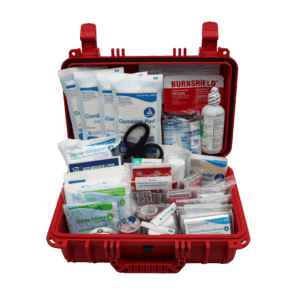Choosing the Perfect Portable First Aid Kit: Your Comprehensive Guide

In today’s market, the array of portable first aid kits can be overwhelming. Everyone wants a kit that offers both value for money and high-quality supplies. However, it’s often challenging to assess the kit’s quality and contents when shopping online. To help you make an informed decision, we’ve compiled some essential tips to guide you in choosing the right portable first aid kit.
- Determine the Purpose of Your Portable First Aid Kit
The first step in selecting a portable first aid kit is understanding its intended use. Is it for personal or family use, or is it for your workplace? This distinction is vital because family first aid kits don’t need to meet the ANSI/ISEA Z308.1-2021 compliance standards. When choosing a family kit, you have more flexibility to customize it according to your family’s specific needs.
For workplace first aid kits, your employer should determine whether a Class A or Class B kit is required, taking into account state and industry regulations. Some states may not have specific requirements, but it’s essential to comply with any relevant regulations.
- Select the Right Container
The type of container you choose depends on your lifestyle and the intended use of the kit. Consider your preferences:
- Cordura EMT/Medic-style Bag: These bags are great for organization and accessibility. They come in various sizes and can be a convenient option.
- Durable Cases: If you need a kit for your vehicle, camping, or outdoor adventures, look for metal or heavy-duty waterproof cases. These are designed to withstand extreme conditions while keeping contents safe and dry.
- Lightweight and Disposable: If you prefer something more disposable or lightweight, inexpensive plastic boxes with gaskets can be a suitable choice. They often come with water-resistant features.
- No Container: Some people prefer not to use a container at all. They keep a drawer stocked with first aid supplies and pack a small personal kit in a seal-top sandwich-style bag.
- Determine the Size You Need
Choosing the right size for your portable first aid kit depends on several factors:
- Group Size: Consider how many people the kit will serve at one time. If it’s just for your family, a small to medium-sized kit may suffice. However, if you participate in group activities, ensure the kit can accommodate your group’s size.
- Multiple Kits: Sometimes, having multiple kits is a practical approach. Keep a small pocket-sized kit in your glove box and a larger kit for outings like hiking, camping, or road trips. Additionally, consider a wall-mounted cabinet for home storage and restocking your smaller kits.
- Set Your Budget
Budget plays a role in your kit selection. While you can find inexpensive kits at local stores, these may not contain a comprehensive assortment of supplies. Here are some budget options:
- Affordable Kits: Good quality kits with essential supplies and reasonable pricing are available. For instance, our Handy Kit Deluxe First Aid Kit is an excellent value option at just $23.15.
- Higher-End Kits: If you’re looking for a more comprehensive kit for a larger family or outdoor activities, options like our Red Rugged Class A First Aid Kit, priced at $256.40, offer robust selections.
- Know What Supplies Should Be Included
At a minimum, a family portable first aid kit should contain:
- Assorted bandages (50-100)
- Antibiotic ointment
- Antiseptic wipes (10-20)
- First aid tape
- Trauma pad (5″ x 9″, 1-2)
- Non-adherent pads (2″ x 3″ or 3″ x 4″, small box)
- Rolled gauze (2″, 3″ or 4″, 1-2 rolls)
- Burn treatment (10-12)
- Hydrogel burn dressing (around 4″)
- Scissors and tweezers
- Gauze pads (3″ x 3″, small box)
- First aid guide
- Triangle bandage (for use as an arm sling)
- Emergency blanket (small, mylar/foil type)
Additional Recommended Items by ISEA
Consider including the following items for a well-rounded kit:
- CPR shield with a one-way valve
- Medical exam gloves (2 pairs)
- Eye wash (1oz or 4oz bottle)
- Eye pads (1 pair)
- Cold instant ice pack (small, 1-2)
- Hand sanitizer (small packets or bottle)
In conclusion, choosing the right portable first aid kit involves assessing your needs, selecting the appropriate container, considering the size, budget, and understanding the essential supplies required. Whether for your family or workplace, a well-equipped first aid kit can be a lifesaver in emergencies.
Feel free to browse our selection of portable first aid kits to find one.
